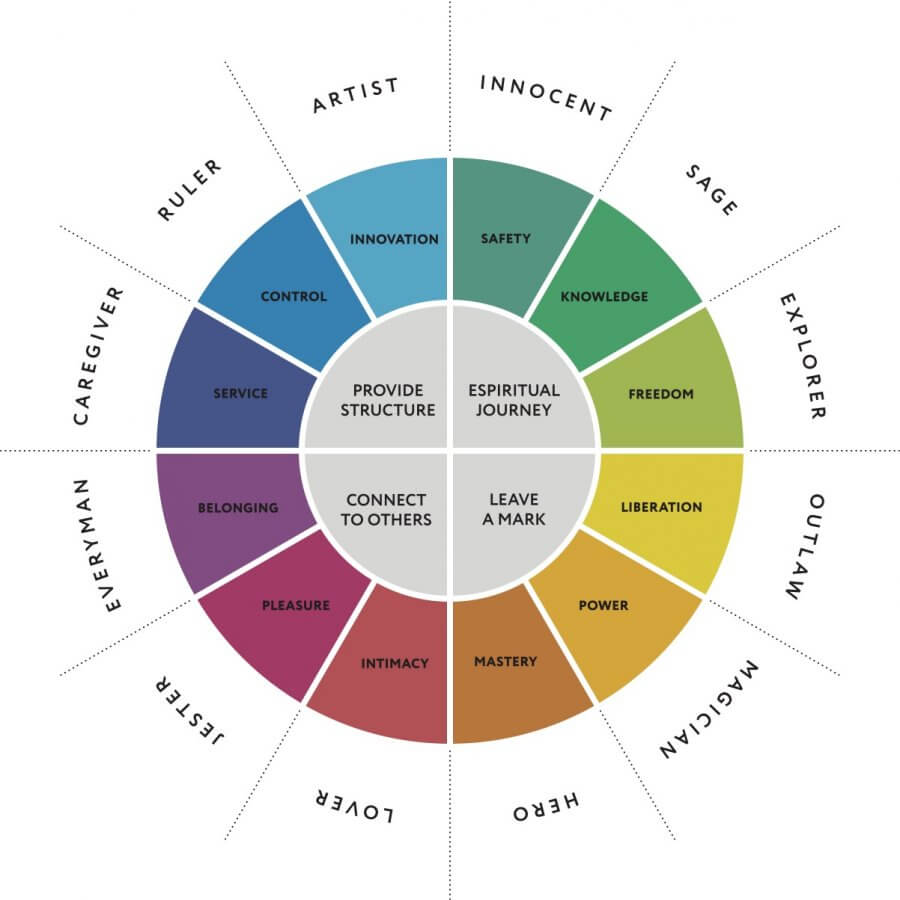We marketers love patterns. Patterns tell us how, when, and where to communicate with customers.
They also tell us a lot about who the customer is. By identifying patterns among your past or existing customers, you can figure out what type of person benefits most from having your product or service in their life.
Then, you can go out and find more people like that person.
Customer archetypes and buyer personas are both helpful strategies when you’re trying to find those patterns.
What Is a Customer Archetype?
Customer archetypes are a way to understand and describe the motivations of your customers as a group.
What are their goals? What drives their decisions?
Archetypes attempt to answer those questions.
Typically, archetypes come in the form of a one- or two-word “character” description that summarizes your ideal customer.
- The Innovator
- The Mother
- The Practical Everyman
- The Free-Spirited Explorer
It’s a way that marketers simplify customer segments in order to serve them better.
If we know that someone’s primary motivation is practicality, that starts to tell us what kinds of products and advertisements might appeal to them. We can use that information in every stage of a marketing campaign, from product development to promotion.
Of course, archetypes rely on oversimplification. Every mom is more than just an archetypal “Mother” figure.
But if you’re marketing cribs, car seats, or baby food, you’re not speaking to the other parts of the mother’s personality — you’re speaking to the part of them that’s primarily concerned with their child’s health, safety, and happiness.
Note that customer archetypes have nothing to do with demographics. We’re not talking about income, locations, ages, genders, or data like that.
It’s more about representing your customer as a fictional character so that everyone in your organization, from your product development team to your social media people, understands who they’re talking to.
How to Identify Customer Archetypes Among Your Clients
Building customer archetypes is actually pretty easy:
1. Talk to Your Customers
Talking to your customers directly will give you a more solid idea of what they want and what motivates them to purchase something.
Whether you use surveys or just talk to them one-on-one, find out things like:
- How they learned about your business
- What about it appealed to them
- What problems does your product solve for them
- What their purchasing process is like (how they decided that your product was the right one for them)
You can even put together a list of archetypes and ask them to choose the one they feel best describes them.
Depending on the size of your company, you may have to hear from a few dozen of them to get a good representation of your client base.
But if you’re a smaller company with a more concentrated clientele, you should talk to each of your clients individually. They’ll appreciate your curiosity, and it will probably even help you serve them better.
You might even incorporate surveys into your sales and onboarding strategies moving forward. More data is always better, and the best time to start learning about your customers is the day you meet them.
2. Use Jung’s Archetypes as Inspiration
The term archetype actually comes from Carl Jung, a 20th-century psychologist. In an effort to understand the motivations behind human behavior, Jung came up with a system of 12 archetypes. He believed that every human being fit into one of these descriptions.
His archetypes are a good place to start when trying to understand your customers:
In the archetype wheel above, each section of the grey inner-circle describes a motivation; the rainbow-colored middle layer describes that archetype’s primary value; and the words on the outer layer are the names of each archetype.
The terms he uses are outdated, but you can rename them as you see fit. Instead of Knowledge-Seeking Sage, you might use Ever-Curious Student. Instead of Controlling Ruler, you might use Ambitious Leader or Badass Boss.
You don’t have to use Jung’s archetypes at all if you don’t want to. Any system will work, as long as it helps you paint broad-stroke pictures of who your customers are and how they think.
Tip: You should be able to identify multiple archetypes within your customer base, so don’t limit yourself to just one. This strategy works best as a market segmentation tool, allowing you to categorize your customers into different groups.
Every company has a few different types of customers. For instance, Jeep has vehicles designed for off-road, adventure-seeking hikers, but they also have vehicles for practical, money-conscious parents. These products solve different pain points, have different value propositions, and require different customer archetypes.
3. Write a Descriptive Paragraph to Accompany Each of Your Archetypes
Customer archetypes work best when they take this format:
- Archetype name
- Brief description
A presentation slide that just says Customer Archetype: The Office Influencer might not make much sense to your audience.
Adding a few descriptive sentences can provide a more holistic portrait of your customer, like this:
The Dedicated Athlete
Always in pursuit of a new athletic goal, the Dedicated Athlete wakes up early, trains endlessly, and strives to achieve greatness. They’re looking for a brand that’s as invested in their success as they are.
What Is a Buyer Persona?
Buyer personas (or customer personas) are another customer segmentation tool.
They’re similar to archetypes in that they depict the ideal customer as a fictional character.
But personas get a lot more specific in terms of data.
Whereas archetypes are typically a short, poetic embodiment of the customer’s motivation, a buyer persona is a named character accompanied by different demographic and psychographic points:
Who they are: Age, gender, career, hobbies, education level
Pain points: Problems they encounter in their day-to-day life
Purchasing patterns: How they make purchasing decisions, budgetary info
Motivations: Values that drive their decision-making process
Influences: People who affect their purchases
So, as an example, your persona might look something like this:
Name: Melissa/Mike
Age: 40
Gender: Male or female
Job role: Construction project manager for a company generating $15M annually
Income: $70,000
Pain points: Existing project management software options aren’t comprehensive enough. Wants a program that allows them to organize all project-related information and correspondence within one interface.
Motivations: To work more efficiently so that they can save money for their organization, shorten the average project timeline, and leave work on time/spend more time with their kids.
Buying patterns/influencers: Needs approval from Chief Construction Officer to implement new project management software on a company-wide level. Purchasing department must approve the expense.
Why Are Buyer Personas Useful?
Just like archetypes, buyer personas tell you what your ideal buyer is looking for. This is enormously helpful in the product design process, as the goal is to build a product that solves your customers’ pain points more than your competitors’ products do.
If we interview a few dozen construction project managers and find that the desire for better PM software is a common thread, that tells us we should get to work on building the best, most comprehensive program we can.
It’s useful for sales and marketing, too. We know that the Chief Construction Officer and purchasing departments have the final say about whether or not to buy, so it may help to direct at least some of our messaging toward them.
In the context of content marketing — which is what we do here at Intergrowth® — that might mean creating some content that speaks to the pain points of CCOs and construction buyers in addition to project managers.
It might also help to create some content that anticipates the questions or concerns these figures will have about buying a new software program and addresses them before they even have to ask.
See also: The Definitive Guide to Content Marketing
Buyer Persona vs. User Persona
Keep that in mind that the person who buys your product isn’t always the end-user. For instance, if you sell SEO software designed for content marketing teams, your end-user might be writers, editors, and SEO strategists.
However, a marketing manager or even the Chief Marketing Officer may be the person responsible for actually buying the software.
For sales and marketing purposes, our buyer persona would focus on whoever makes the final purchase decision. The user persona, on the other hand, would profile the writers and SEOs who actually use the software. Building a buyer persona requires buyer research, rather than user research (although it is always helpful to understand the relationship between the two).
Buyer Persona vs. Ideal Customer Profile
Ideal customer profiles are similar to buyer personas, except that they describe companies instead of individual people.
It’s used in the B2B world where the target buyer is other companies, not individuals. Instead of outlining what a person’s job title is or their income, ICPs outline company budgets and which job role is responsible for making the final purchase.
In most cases B2B companies use ICPs and buyer personas. The former helps them to identify companies that might be potential customers, and the latter helps them understand the motivations of the person making buying decisions.
You might also be interested in: Hiring a B2B Content Marketing Agency: Is It Worth the Cost?
How to Create a Buyer Persona
Here’s how to build buyer personas:
1. Collect Data
As with customer archetypes, creating buyer personas is easier if you have a lot of data to work with.
Create a form with the information points you want to include in your persona (career, income, influencers, etc.). Then, pull up a list of your ten or twenty best customers and fill out a form for each of them using the information you know.
If you can’t fill out a line on the form, either make an educated guess or ask them if you can survey them for a marketing exercise.
You can also ask other members of your team. Sales reps usually collect data on leads and prospects, so they might be able to tell you things you didn’t know about your customers.
2. Look for Patterns
Consolidate your data into one spreadsheet, with each information point in its own row or column. This makes it easier to find patterns in the data.
Look for the data points that appear most frequently — common job titles, pain points that show up over and over, etc. Find the median income of all the customers you’re looking at to determine the income of your buyer persona.
3. Work With Your Creative Team to Build Out a Full Persona
Once you’ve identified the patterns that illustrate your target audience — that’s your buyer persona. Have your designers and content team work their magic and turn your persona into something visually interesting.
You and other people in your company are probably going to show the persona in presentations, so it’s to have a branded slide with an illustrated picture of the “person.”
4. Share It With Your Team
Everyone in your company will benefit from seeing the buyer personas you’ve drawn up.
Whether they design products, close deals, or troubleshoot problems over the phone, everyone should be on the same page about who the target audience is and what they’re seeking.
Related: Our Full Guide to B2C Content Marketing
Do You Need Customer Archetypes and Buyer Personas?
Can you get away with just having one or the other? What if you don’t want to use either?
That’s fine — customer segmentation isn’t a necessity,
However, these tools can help you align your business with the values and motivations of the people most likely to buy your products.
Even if you don’t go through the whole process and create a fully fleshed-out portrait of your target customer, reviewing your customer data is a helpful exercise.
Like I said up top, if you can figure out what all of your best customers have in common, you can focus your marketing efforts on finding more people who share those traits.
Learn about our what it looks like to work with Intergrowth® here!
SCALE YOUR ORGANIC TRAFFIC
Subscribe to our monthly newsletter





